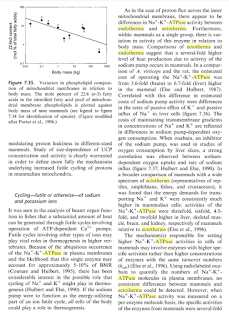Na/K ATPase - thermogenesis & energetic cost
There's this book I want to get, Hochachka and Somero's Biochemical Adaptation (or the latest edition, which is by Somero et al.); of course since it is a science book it is ridiculously expensive and there's no ILL in a pandemic. The book has some interesting passages (p. 402) on Na/K ATPase that are visible on Google Books preview. I took a snip since there's no cut and paste:
Main points:
- futile cycling of ions may play a vital role in thermogenesis
- Na/K ATPase may account for 5-10% of BMR
- there are differences in Na/K ATPase activity between ectotherms and endotherms
- 7x higher activity in mammals
- "Correlated with this difference in estimated costs of sodium pump activity were differences in in the rates if passive efflux of K+ and passive influx of Na+ in liver cells. The costs of maintaining transmembrane gradients in concentrations of Na+ and K+ are reflected in differences in sodium pump-dependent oxygen consumption."
- the degree of difference in Na/K ATPase activity between mammals and ectotherms varies by tissue type; the largest is in skeletal muscle (6x)
- the differences between mammals and ectotherms are due to higher specific activities rather than rather than higher amounts of the enzyme
I think I had seen in a preview from a different edition something about
membrane fluidity and membrane fatty acid composition
differences affecting Na/K ATPase activity. I need to get the latest edition somehow.
Hochachka, Peter W, and George N Somero. Biochemical Adaptation: Mechanism and Process in Physiological Evolution. New York: Oxford University Press, 2002.
~
keywords: body temperature, thermogenesis, sodium pump, ion channels, metabolism, cell membrane

Comments
Post a Comment